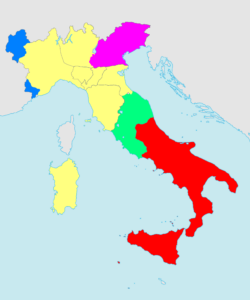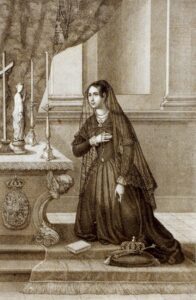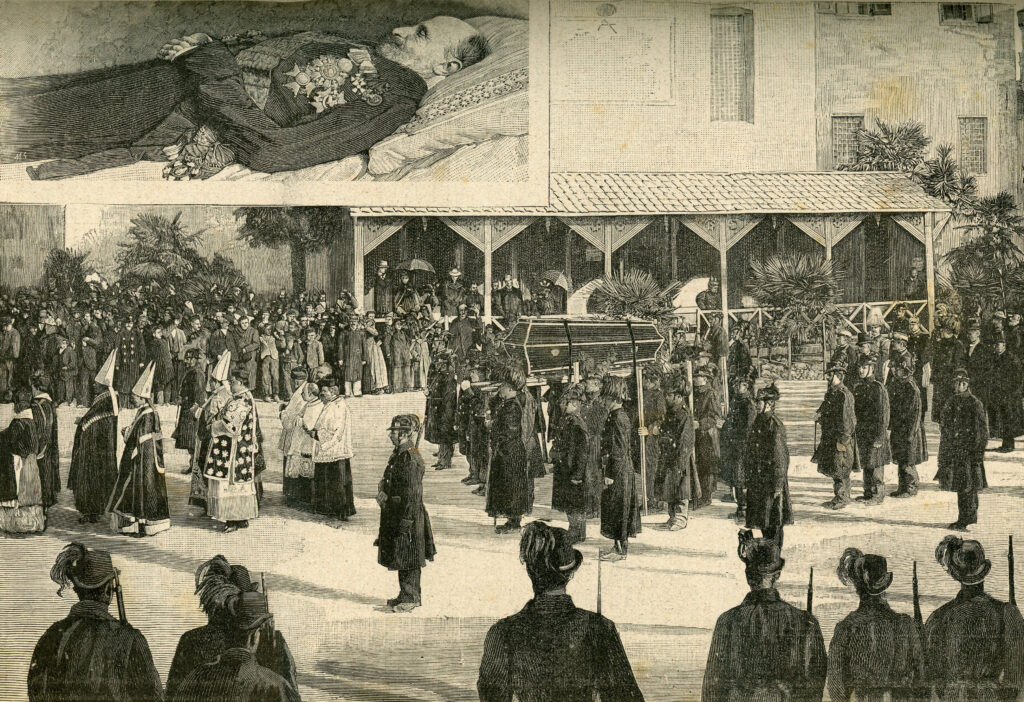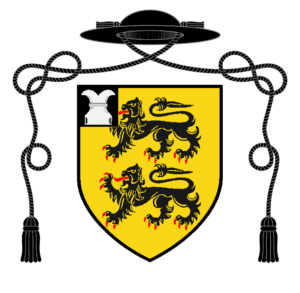The Blessed Karl of Southern Italy

by Fr. William Rock, FSSP
Many readers of the Missive are no doubt aware of the devotion found in traditional circles to Blessed Karl of Austria and his wife, Servant of God Zita. This devotion is founded primarily on the recognition of their virtues, but there is the strong influence of what they represent. As the last Catholic Emperor and Empress, their lives and deaths represent a delineation between a previous order of the world and the present one. As the last monarchs of the Austro-Hungarian Empire, their unjust and forced dethronement is seen as the death of Christendom, the spirit of which many traditional Catholics prefer over the spirit which pervades the world today. For the spirit of Christendom built civilizations, guided nations, and allowed the Catholic Faith to penetrate and infuse every aspect of the faithfuls’ lives.
There is little doubt that Blessed Karl and his devotees would find a kindred spirit in Servant of God Francesco II1 of the House of Bourbon, the last King of the Kingdom of the Two Sicilies. He ruled over a kingdom which encompassed the southern part of the Italian peninsula and the island of Sicily. This territory was first organized as a kingdom in A.D. 1130 with the crowning of the first King of Sicily, the Norman Roger II. Yet the foundation of the Kingdom of the Two Sicilies, Il Regno, are rooted deep in history, going back from the time of Roger II to the various, prior districts governed by the Lombards, Normans, Byzantines, and Muslims, to the former provinces of the Roman Empire, and finally back to the original Greek colonies of Magna Græcia and the settlements of the Phoenicians.

For his part, Francesco d’Assisi Maria Leopoldo was born on 16 January 1836 to King Ferdinando II and Queen Maria Cristina of Savoy, (herself a Blessed whose “religious devotion was legendary”2). The Queen died “in 1836 from complications giving birth to her only child.”3 Having lost his mother so soon after his birth, Francesco turned to the Blessed Virgin Mary and developed a strong, filial devotion to her. His education was overseen by the priests and members of the court. “Like his mother, Francesco was very devout, thought by many to be more seminarian than soldier.”4
After his father’s death, Francesco II ascended the throne of Il Regno on 22 May 1859 at 23 years of age. The first year of his reign was one of great activity – projects, improvements, and reforms – undertaken for the sake of his citizens and the good of the Kingdom. But, the French Revolution still casting its long shadow, his benevolent and industrious reign was fated to be short. In May 1860, colluding with and aided by the Kingdom of Piedmont-Sardinia (located in its insular namesake and the north of the Italian peninsula) and with the assistance of the British, Giuseppe Garibaldi’s Expedition of the Thousand landed in western Sicily. In August of the same year, Garibaldi’s troops crossed over to the mainland, bribing officials to treason along the way. Out of love for his people and their patrimony, in early September, Francesco withdrew from Naples, the capital city, to the fortress of Gaeta, located on the western coast midway between Naples and Rome, where he and his wife, Queen Maria Sophia of Bavaria, having left behind their personal wealth and belongings, took refuge with 20,000 troops. Francesco himself fought on the walls with his men while his wife served as a nurse. After several months of siege and bombardment, on 13 February 1861, faced with impossible odds, the fortress surrendered. On 14 February 1861, the King and Queen left the fortress among the tears of their troops, who remained loyal until the end, with a military farewell. They were received aboard a ship waiting in the harbor, and the flag of Il Regno was struck.

Francesco II lived the rest of his life in exile, first in Rome and then, after Rome itself was taken by Piedmontese forces, in Paris and Vienna, with his latter days in Arco. During his exile, he was well-known for his generosity to those in need – no one went away without some assistance. He spent his last days simply in Arco, his royal personage concealed. In the mornings he would attend daily Mass and, in the evenings, return to the church to pray the rosary in common. “Francesco died in Arco, in Trent, then part of Austria”5 on 27 December 1894, the Feast of St. John the Apostle. It is fitting that one who adopted the Blessed Virgin as his mother die on the feast of him to whom Our Lord entrusted His mother while hanging on the cross.
Like Karl of Austria, Francesco II was unjustly and forcefully removed from his throne and lived the rest of his life in exile. But also like the good Emperor, the good King is distinguished more for his Christian faith and virtue than for his royalty. Among the testimonies to his virtue, may it suffice here to quote one of Francesco’s descendants, Charles of Bourbon-Two Sicilies, Duke of Castro, to illustrate the truth of the matter:
Francis II had a varied and complex personality. In the few months of his reign, he was unable to put an end to a crisis which had begun far away, of which he had been bequeathed the difficult inheritance. But still, throughout the course of his life, he knew how to give ample proof of total closeness and identification with the peoples he governed. Not only because he prevented the destruction of Naples.
Giving precise orders to the garrisons present in the city to not shoot upon the arrival of Garibaldi’s troops, but above all, during the battle of Volturno and the following siege of Gaeta, he did so in a way that none of the prisoners, Garibaldi’s men first, and then the Piedmontese, would be treated villainously, as was then the practice among the troops fighting him.
Deeply Catholic, Francis II made of Christian doctrine a doctrine of life, always relieving the sufferings of his people, even following the fall of his Kingdom. And, although restricted economically, his aid was never lacking to those who asked him for it. He always had the dignity of a King.
And throughout his life, made up of mourning and suffering, the least of which was the loss of his only and most beloved daughter, Maria Christina, he faced all of these trials with Christian patience. So much so, to cause Pius IX to say that Francis II resembled a little “Job.”
If you, dear reader, are moved in any way by the preceding, consider taking on the Servant of God Francesco II as a patron, or, perhaps, his mother, Blessed Maria Cristina, as a patroness. And further, if you are so convicted, request a favor through his (or her) intercession, so that God may, by the working of miracles through his (or her) patronage, soon raise them, along with Karl and Zita, to the altars –these last saints of Christendom.
Blessed Karl of Austria, Pray for us!
Blessed Maria Cristina, Pray for us!
Servant of God Francesco II, Pray for us!
Servant of God Zita, Pray for us!

Favors obtained through the intercession of Servant of God Francesco II can be submitted to his Postulation by mail at “Service for the Causes of Saints, Largo Donnaregina 22 – 80138 – Naples (NA), Italy” or by email at postulazione@francescosecondodiborbone.it.
Prayer to Servant of God Francesco II
One and Triune God, Who casts Your glance on us from Your throne of mercy, and called Francis II of Bourbon to follow You, choosing him on earth to be king, modeling his life on the very Kingship of Jesus Christ, crucified and risen, pouring into his heart sentiments of love and patience, humility and meekness, peace and pardon, and clothing him with the virtues of faith, hope and charity, hear our petition, and help us to walk in his footsteps and to live his virtues. Glorify him, we pray You, on earth as we believe him to be already glorified in Heaven, and grant that, through his prayers, we may receive the graces we need. Amen.
A League of Prayer and Charity has also been established to promote the cause of Servant of God Francesco II and to aid his devotees in imitating his virtues.
Favors obtained through the intercession of Blessed Maria Cristina can be submitted to her Postulation by mail at “Postulation of the Cause, Via Santa Maria Mediatrice, 25, 00165 Rome, Italy” or by email at postgen@ofm.org.
Prayer to Blessed Maria Cristina
Let us pray: O God, You adorned Blessed Maria Cristina with diligent and wise charity, so that by her witness, she would contribute to the building up of Your Kingdom. Grant us also by her example, to do good, drawing on the true riches of Your Love. Through her intercession, grant us the grace of […] which we ask with confidence. Through Christ our Lord. Amen.
Holy Cards of Blessed Maria Cristina and of Servant of God Francesco II can be obtained by contacting info@smocsg.org.
Additional information about the Servant of God Francesco II can be found in this episode of the Italian American Podcast. Those who can read Italian may be interested in the book Francesco II, Il Re Cattolico.

In conformity with the decrees of Pope Urban VIII, in no way is this article intended to anticipate the ecclesiastical authority; the above prayers are not intended for public use.
Fr. Wiliam Rock, FSSP was ordained in the fall of 2019 and is currently assigned to Regina Caeli Parish in Houston, TX.
- His name might also be rendered as Francis II in English, as presented in a quote later in the article. I have chosen to use Francesco, which follows the usage of author Louis Mendola.
- Mendola, Louis. The Royal House of the Two Sicilies: An Introduction to the Orders of Chivalry. (New York: Trinacria Editions; copywrite New York: American Delegation of Sacred Military Constantinian Order of St George Naples Two Sicilies Inc, New York, 2021), p. 46.
- Ibid., p. 46.
- Ibid., p. 48.
- Ibid., p. 49.
December 27, 2023









